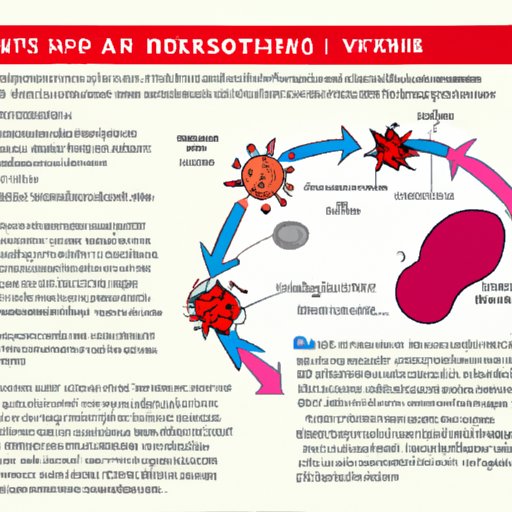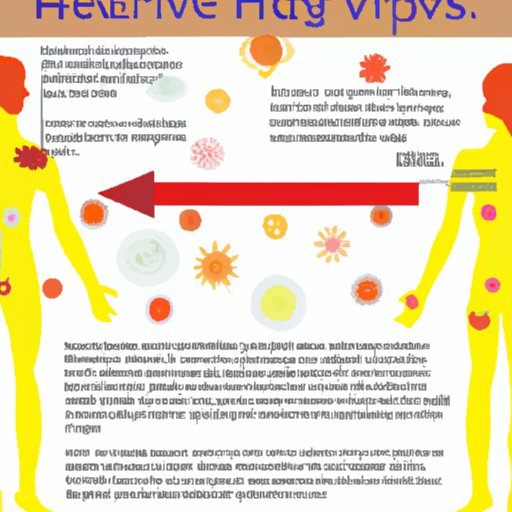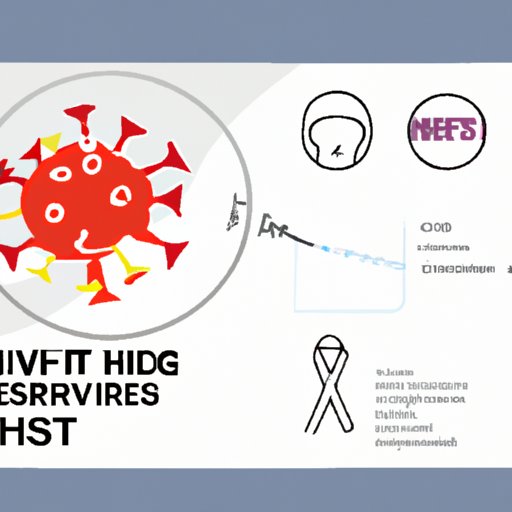Introduction
HIV, or Human Immunodeficiency Virus, is a virus that can lead to Acquired Immunodeficiency Syndrome (AIDS). It has been a major health concern since it was first identified in the early 1980s, and although there is no cure for HIV, there are treatments available to help manage and control the virus. In this article, we will explore the pathology of HIV, the biology of the virus, how it is transmitted, the effects on the body, and the available treatment options.
Exploring the Pathology of HIV: How Does It Work?
HIV is an infectious virus that attacks and destroys cells in the immune system, including T-cells, which help the body fight off infection and disease. As it spreads through the body, it gradually weakens the immune system, making it harder for the body to fight off other infections and diseases. Without treatment, HIV can eventually lead to AIDS, which is a life-threatening condition.
HIV is most commonly spread through sexual contact with an infected person, but it can also be spread through sharing needles or from mother to baby during pregnancy, birth, or breastfeeding. It cannot be spread through casual contact such as hugging, kissing, or shaking hands.

Breaking Down the Biology: A Primer on HIV
HIV is a type of retrovirus, meaning it contains genetic material in the form of RNA instead of DNA. The virus enters the body and uses an enzyme called reverse transcriptase to convert its RNA into DNA. This newly converted DNA then integrates itself into the host cell’s DNA, allowing the virus to replicate and spread throughout the body.
HIV has a complex lifecycle, beginning with the virus attaching itself to a healthy cell, entering the cell, and converting its RNA into DNA. Once inside the cell, the virus replicates, producing more copies of itself. These copies then break out of the cell and infect other healthy cells, continuing the cycle.

The Story of HIV: How It Spreads and Impact the Body
HIV is most commonly spread through sexual contact with an infected person, either through vaginal, anal, or oral sex. It can also be spread through sharing needles or syringes, or from mother to baby during pregnancy, birth, or breastfeeding. It cannot be spread through casual contact such as hugging, kissing, or shaking hands.
Once inside the body, HIV targets and destroys the immune system’s T-cells, making it harder for the body to fight off other infections and diseases. As the virus continues to spread, it can lead to a weakened immune system and eventually to AIDS, a life-threatening condition.
Investigating the Immune System: What Happens When HIV Attacks?
The immune system is the body’s natural defense against infection and disease. It is made up of a network of organs, tissues, and cells that work together to identify and fight off foreign invaders like bacteria and viruses. When HIV enters the body, it targets and destroys the T-cells in the immune system, making it harder for the body to fight off other infections and diseases.
Without treatment, HIV can eventually lead to AIDS, which is a life-threatening condition caused by severe damage to the immune system. People with AIDS are more susceptible to opportunistic infections, which are infections that take advantage of a weakened immune system. These infections can be serious and even life-threatening.
Understanding the Treatment Options: Controlling the Virus with Medication
Although there is currently no cure for HIV, there are treatments available to help manage and control the virus. These treatments involve using medications to reduce the amount of virus in the body and keep it at a manageable level. With proper treatment, people with HIV can live long and healthy lives.
Antiretroviral therapy (ART) is the most common form of treatment for HIV. ART involves taking a combination of antiviral medications to reduce the amount of virus in the body and keep it at a manageable level. ART can also help prevent the virus from spreading to other people.
Conclusion
In this article, we explored how HIV works, from its pathology and transmission to the effects on the body and the available treatment options. We discussed the structure and replication of HIV, how it is transmitted, and how it affects the immune system. We also looked at the available treatments and medications used to control the virus. Although there is no cure for HIV, with proper treatment, people with HIV can live long and healthy lives.
(Note: Is this article not meeting your expectations? Do you have knowledge or insights to share? Unlock new opportunities and expand your reach by joining our authors team. Click Registration to join us and share your expertise with our readers.)
